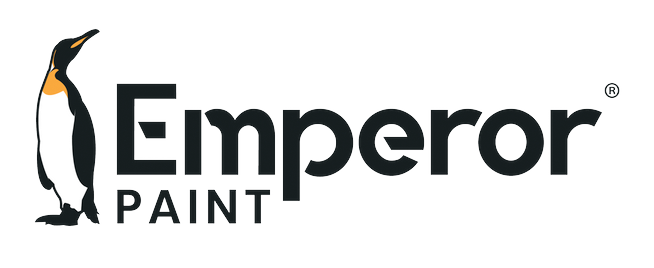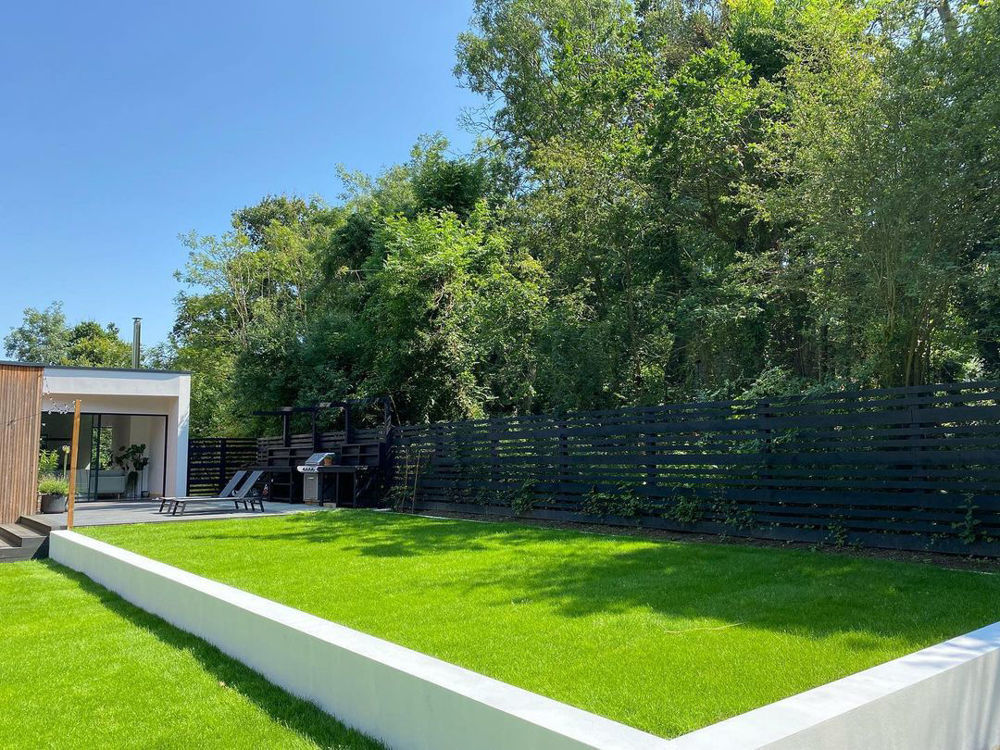
Taking on any DIY project can be a daunting task for many, but anyone can completely transform a space with a bit of advice. Both previously painted walls and exposed brickwork are perfect opportunities to a brand-new look to your outdoor space, giving it a new lease of life. Here is our expert's guide to painting garden walls.
What Paint Should You Use?
The first place to start when painting any surface is with the paint you are going to use, after all, if you get this wrong the project will be a disaster before you have even started. Not all paint is suitable for use on exterior surfaces due to the conditions that the paint must endure. Masonry paint is a type of exterior paint that is specifically designed to be applied to exterior walled surfaces, such as brick, stone, concrete & renders. It has been developed to remain adhered to exterior walls through all weather, from hot summers to freezing winters.
As with all paints, masonry paint can vary in characteristics and quality. Some masonry paints are developed to solve small exterior DIY projects cheaply and will last 1-3 years, while some are designed to provide long-term protection over 20+ years. The importance of the quality of paint you are using & the durability it provides is significantly increased when it comes to any exterior paint due to the high number of external factors that can impact the performance of the paint. The single biggest cause of exterior paint failure is moisture. It is a relatively unknown fact amongst homeowners but bricks actually absorb moisture due to them being porous. This is also the case with standard acrylic masonry paints, which is what most masonry paints available in the UK are. When rainwater falls on the exterior wall, the paint is absorbed by the paint and the substrate underneath, eventually gathering underneath the paint film. This moisture then saturates the surface, causing the paint to peel, bubble & flake. The moisture rich conditions also provide an ideal environment for fungus and other green growth to grow on the exterior wall, along with staining and damp patches that discolour the wall over time.
While most masonry paints refer to themselves as 'weatherproof' or 'shower proof', these paints are not completely waterproof and will allow some level of moisture to be absorbed into the exterior wall. To be waterproof, a masonry paint must be able to repel water, which is where super hydrophobic waterproof masonry paints come in. These masonry paints offer water repellent abilities that causes water to simply roll straight off the painted surface, preventing the water from soaking into the wall and getting behind the paint film. This water repellent surface is not enough to protect exterior walls however. These paints must also not impact the breathability of the exterior wall. If the wall cannot breathe, moisture that naturally occurs within the surface will become trapped, eventually building up until the paint film is broken, causing the paint to fail. By remaining highly breathable, water vapour can freely escape the wall and the substrate remains dry, even when coated using a waterproofing treatment.
Our own Emperor Masonry Paint is one such paint that was specially developed to provide the highest possible performance when in comes to exterior paint. In an independent test it was found to prevent 96% of water absorption, had an SD value of 0.03 which is highly breathable and after a 25-year period of heavy weathering showed no signs of deterioration in performance or appearance. Due to this, Emperor Masonry Paint comes with a lifetime guarantee, ensuring its performance for decades to come.
One of the most difficult parts of having a painted garden wall is keeping it clean, especially if you have a white wall. One of the key reasons why many homeowners opt for a super hydrophobic masonry paint is that it is self-cleaning. The super hydrophobic surface that is created makes it difficult for any dirt to attach itself to the garden wall, plus due to the water repellent coating that is created, any dirt is washed off with rainfall. Similarly, by preventing the moisture rich conditions that allows fungus to grow on the wall, the wall remains free from discolouration and damp problems that can stain the surface.
While a cheap masonry paint may be suitable for your project, consider opting for a waterproof masonry paint such as Emperor Masonry Paint if you want a maintenance free garden wall that will guarantee you won't have to repaint the wall in a matter of years.
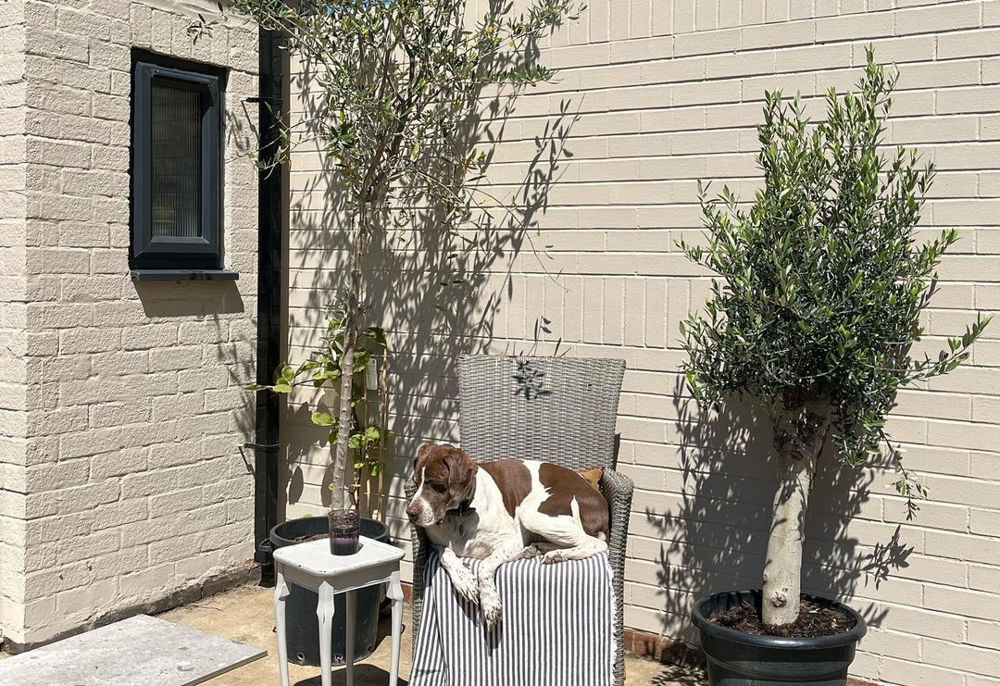
How Much Paint Do I Need?
Once you have decided what masonry paint you are going to use to paint your garden wall, the next step is estimating how much paint you will need to complete your project. This is something that can cause many DIY'ers headaches, but it doesn't have to be that way.
There are three things you must consider when estimating the amount of paint you will need are; the size of the wall, the coverage of the paint & the number of coats you will need. Firstly, to estimate the size of the area you will be painting simply measure the length of the wall and the height of the wall in metres. When you multiply these numbers together, you will get the total square metres of the wall. The coverage of masonry paint varies from paint to paint, with Emperor Masonry Paint for example having a coverage 5-6m² per litre on smooth surfaces. On rough exterior walls such as pebbledash, the coverage of the paint could be half of what it is on a smooth masonry surface. Always check with the product data before buying in order to best estimate the coverage of the masonry paint you are using. Finally, all you have to do is check how many coats of paint you will need, which with a good-quality masonry paint will almost always be two coats, while cheaper masonry paints may take three coats. As a guide, Emperor Masonry Paint on a smooth retaining garden wall of 18m² will require roughly 6L of paint, although we would always recommend buying slightly more paint than you need just to be sure.
How To Paint A Garden Wall
When you have your masonry paint ready, it is time to get painting. Make sure you give yourself enough time to complete the project without it raining, as this could ruin your project if the paint has not had a chance to become showerproof. It is recommended that you allow at least two days to fully completely the project. Furthermore, if you are using a water-based masonry paint, which is the case 9 times out of 10, do not paint in temperatures under 5°C. This is because the paint will struggle to dry at these temperatures.
YOU WILL NEED:
- Masonry roller (long-pile roller)
- Paint tray or scuttle
- Synthetic paint brush
- Dust sheet
- Masking tape
- Masonry paint
- Exterior filler & filling knife (may be required)
- Scraper (may be required)
- 120 grit sandpaper (may be required)
1. PREPARATION
Preparation is one of the most important parts of the decorating process, which is why it is crucially important that you take time at this stage as it will pay dividends with the finished results.
The very first part of the process for preparing exterior walls is to ensure the surface is sound. Often the elements can take their toll on the brick or stone causing it to crack. By repairing these cracks or holes, you ensure that moisture cannot find its way into the wall. Start by removing any loose material from the hole that may prevent the filler from adhering. Once this has been done, fill the surface using a good exterior filler such as the Toupret Masonry Repair Filler. When this has been left to completely dry, sand it back to a smooth edge using a 120-grit sandpaper.
A step many DIY'ers miss when painting garden walls is the cleaning. If the surface is not clean & free from fungal growth, the paint may not adhere at first and over time any fungus can bloom, causing the paint to fail. Start by washing the wall down with a garden hose to remove any dirt and rumble from the surface. You can then apply a fungicidal masonry cleaner such as Emperor Masonry Cleaner to the garden wall using a brush, which will completely kill any bacteria and ensure the surface is completely clear of contamination. Allow this dry for a minimum of 2 hours before moving on.
The final part of the preparation process is to cover any surfaces that you do not want to paint in order to achieve the cleanest possible finish. Apply a good-quality exterior masking tape along any the edges of the wall to ensure you can the neatest possible finish. It is also a good idea to put down a dust sheet to save you the trouble of having to clean masonry paint off the floor when you are finished.
2. PRIMING
If you are painting a garden wall that has never been painted before, you must prime it like most other bare surfaces before painting. If you are simply refreshing previously painted masonry, this step is not required.
When using Emperor Paint, you must use the Emperor Paint Primer as this is also water repellent & highly breathable, ensuring full super hydrophobic performance. Masonry primer is a thin, milky substance that can be easily applied using either a masonry roller or a paint brush. It requires just one-coat application and must be applied in completely dry conditions. Apply a thin, even layer of the primer to the masonry, ensuring you cover the full surface. Once you have fully primed the area, leave it to dry completely for 3-5 hours before painting.
3. PAINTING
It's then time to get painting! We recommend starting at the top of the wall and working your way down, as this will allow you to go over any paint drips as you go. Start with a paint brush at the edges, applying your first coat of paint. A synthetic paint brush is best suited for use with a water-based paint, which the vast majority of masonry paints are. You can get specially designed masonry brushes that have highly durable bristles for use on rough surfaces.
When you have painted all edges, you can these use your long-pile paint roller to paint the rest of the surface. We recommend a long-pile roller as this has the longest fibres, allowing you to pick up more paint on your roller and apply it to all of the little gaps on the wall. The aim of this first coat is not to create a solid colour finish but to build a solid layer of paint that will help the slightly thicker topcoat adhere. You can thin your first coat down by 10% to make it easier to apply to the wall, however you should not water down your second coat. Once you have finished your first coat, leave to completely dry as per the manufacturer's instructions, which is up to 8 hours in the case of Emperor Masonry Paint. Once dry, you can then apply the second coat to the wall, ensuring you achieve your desired finish as this will be your final coat of paint. If you are using a good-quality masonry paint, you will only require two coats, however if you are using a paint that has not achieved your desired finish, apply a third. Once the full wall is fully painted, allow to dry and remove your masking tape.
Frequently Asked Questions
Q. CAN YOU PAINT A RETAINING GARDEN WALL?
Yes, a retaining garden wall can be painted, so long that it has adequate waterproofing measures put on the inside of the wall to prevent moisture from the soil leaking through the wall. If a waterproofing membrane is present on the back of your retaining wall, using a highly breathable masonry paint will allow water vapour to escape from inside the retaining wall, helping maintain moisture levels. If a low breathability paint was used, this moisture could build up and eventually cause the paint to fail.
Q. HOW DO I PREVENT REPAIRS BEING VISISBLE ONCE I PAINT?
Garden walls, especially those that have been rendered, can suffer from cracks, holes and other imperfections that need to be repaired when you paint them. The problem is, these repairs are difficult to mask once completed, causing them to draw attention. If you have a textured finish or want to create a textured finish on your garden walls Emperor Textured Basecoat is ideal. It allows a number of textured finishes to be creating using various textured rollers, from light texture to rough texture. This is perfect for masking repairs and matching up various textures to create a seamless finish.
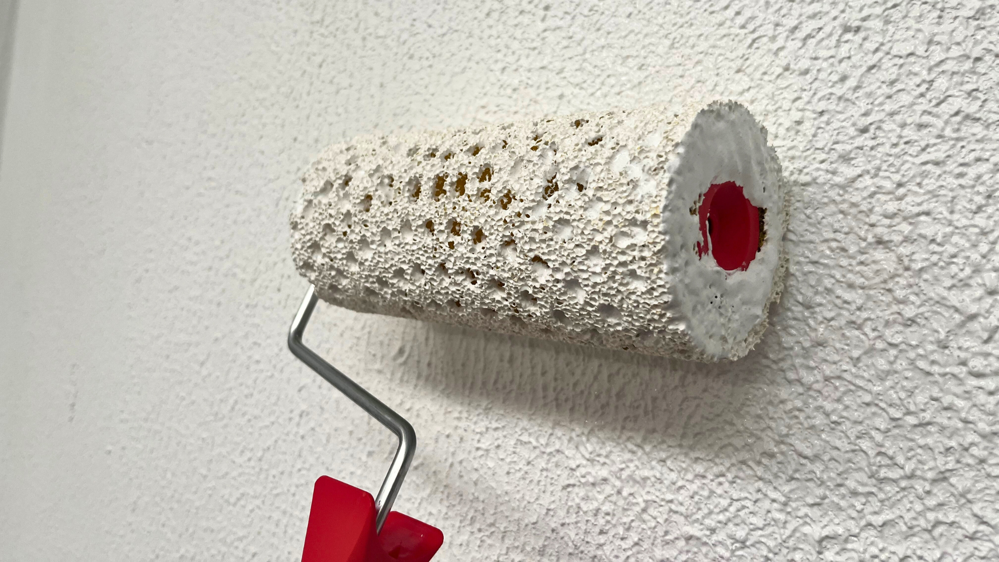
Q. CAN YOU PAINT DAMP GARDEN WALLS?
Garden walls must be completely dry before painting, especially with a water-based paint like the vast majority of masonry paints are. You should not paint a damp garden wall until you have resolved the issue that is causing the moisture. This is usually due to penetrating damp, which is caused by water ingress on an exterior wall. By waterproofing walls using a waterproof masonry paint, this moisture will be prevented and the damp patches should not reappear. Always wait until the temperatures rise and the wall has a had a chance to dry out before you start painting.
Q. WHAT IS BREATHABILITY?
A term that many people are confused with is 'breathability' when it comes to masonry paint. Bare, untreated masonry is both porous (meaning it absorbs moisture) and breathable (meaning it allows water vapour to travel freely). This breathability is crucial for ensuring that the interior of the property can release moisture that naturally builds up from condensation. This means that while preventing moisture entering the building is crucial, allowing moisture to release from the building is even more important, as if it is blocked it will cause significant damage to the building materials and leads to significant damp problems. This is why any masonry paint must be breathable to allow this moisture to escape. Breathability is measured with an SD value, with anything under 1 being considered breathable. In independent tests, an untreated wall was measured at 0.57 while the same wall that was painted with Emperor Masonry Paint was measured at 0.56. This demonstrated that the wall painted with Emperor Masonry Paint remained almost completely breathable compared to when it was left untreated, while it showed it reduced water absorption by 93.4%. This combination of water resistance and breathability is what keeps mineral surfaces dry & free from the moisture that causes deterioration.
Q. WHAT IS THE BEST COLOUR TO PAINT A GARDEN WALL?
There are hundreds of colours to choose from when it comes to painting a garden wall. Masonry paint generally comes in popular exterior shades such as white, cream & grey, which are the three most common colours to paint a garden wall. Our recommendation is painting garden walls white, which is a colour many avoid due to the tendency for it to discolour over time. With a self-cleaning masonry paint, you can enjoy white in all its glory, which can give a clean, crisp and extremely modern look, especially when used in a contemporary garden. We loved what @happyharrishousebuild did with their garden using Emperor Masonry Paint, creating an ultra-modern outdoor space using white rendered walls to encompass their garden.
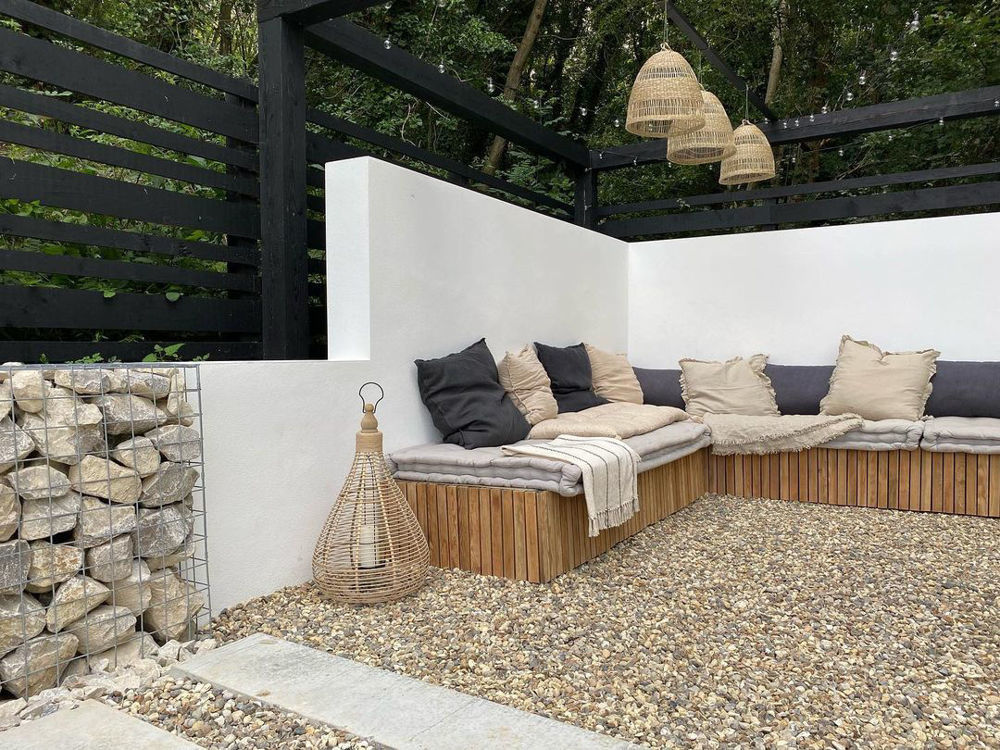
White doesn't have to be boring. It is the perfect colour for creating a background for other decor. This before & after is a perfect example of this, which used a combination of blue & white colours created a serene Greek inspired backyard, packing a lot of character into a small space. They used Emperor Masonry Paint to ensure that green growth that the previous paint suffered from didn't come back, ensuring that their hardwork could be admired long-term.
.png)
Emperor Masonry Paint comes in 18 standard colours, including light grey, white, witney cream and off-white, which are all popular neutral shades for exterior painting. Light grey in particular is a shade that is perfect for a modern outdoor space if you don't want something as bold as white.
Want more information regarding painting garden walls? Our in-house experts are on hand to answer any questions you may have about the full painting process. Contact one of our experts by sending an email to info@emperorpaint.co.uk or shop Emperor Masonry Paint today & get FREE delivery on all orders.

